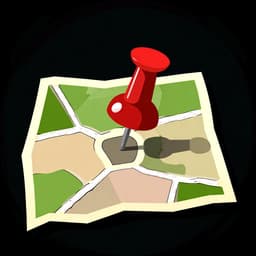Where is the bus stop?
in Spanish¿Dónde está la parada de autobús?
/DOHN-deh ehs-TAH lah pah-RAH-dah deh ow-toh-BOOS/
This is the most standard and universally understood way to ask for the bus stop. It's clear, polite, and works perfectly in any situation or country.

Knowing how to ask '¿Dónde está la parada de autobús?' is a key skill for exploring any new city in the Spanish-speaking world.
💬Other Ways to Say It
¿Dónde queda la parada de autobús?
/DOHN-deh KEH-dah lah pah-RAH-dah deh ow-toh-BOOS/
Using 'queda' instead of 'está' is extremely common in Latin America. It means the same thing ('is located') but can sound a bit more natural and local than 'está' in many regions.
¿Dónde está la parada del bus?
/DOHN-deh ehs-TAH lah pah-RAH-dah del BOOS/
A slightly shorter and more common conversational version. 'Bus' is an easy English loanword that is widely understood, making this a simple and effective option.
Perdone, ¿me podría decir dónde está la parada?
/pehr-DOH-neh, meh poh-DREE-ah deh-SEER DOHN-deh ehs-TAH lah pah-RAH-dah/
This is a very polite, indirect way to ask. It translates to 'Excuse me, could you tell me where the stop is?' Notice you can often drop 'de autobús' if the context is clear.
¿Dónde está la parada del camión?
/DOHN-deh ehs-TAH lah pah-RAH-dah del kah-mee-OHN/
This is the go-to phrase in Mexico, where 'camión' is the most common word for a public bus. While 'autobús' is understood, 'camión' will make you sound like a local.
¿Dónde está la parada del colectivo?
/DOHN-deh ehs-TAH lah pah-RAH-dah del koh-lek-TEE-boh/
In Argentina and some neighboring countries, 'colectivo' (or its slang term 'bondi') is the word for a city bus. Using this term is essential to sound natural there.
¿Dónde está la parada de la guagua?
/DOHN-deh ehs-TAH lah pah-RAH-dah deh lah GWAH-gwah/
'Guagua' is the word for bus in places like Cuba, Puerto Rico, the Dominican Republic, and Spain's Canary Islands. It's a fun word and a key piece of regional vocabulary.
¿La parada, por favor?
/lah pah-RAH-dah, por fah-VOR/
A very abbreviated, quick way to ask. You're essentially just saying 'The stop, please?' with a questioning tone. It's efficient but lacks politeness.
🔑Key Words
Key Words to learn:
📊Quick Comparison
The biggest difference in asking for the bus stop is the regional word for 'bus'. Here's a quick comparison of the most common options.
| Phrase | Main Region | Best For | Avoid When |
|---|---|---|---|
| ...la parada de autobús? | Universal | Any situation, especially if you're unsure of the local term. It's the safest bet. | Never wrong, but can sound a bit formal or foreign in regions with a strong local term. |
| ...la parada del camión? | Mexico | Sounding like a local and being clearly understood anywhere in Mexico. | Outside of Mexico, as 'camión' usually means 'truck'. |
| ...la parada del colectivo? | Argentina/Uruguay | Navigating the public transit systems of Buenos Aires or Montevideo like a pro. | In most other countries, where 'colectivo' might not be understood in this context. |
| ...la parada de la guagua? | Caribbean/Canary Islands | Fitting in perfectly in places like Puerto Rico, Cuba, and the Dominican Republic. | Anywhere else. In Chile, for example, a 'guagua' is a baby! |
📈Difficulty Level
Mostly easy. The main challenge is the word 'autobús', making sure to stress the final syllable: ow-toh-BOOS.
The grammar is very simple: 'Where' + 'is' + 'the bus stop'. It's a direct and straightforward structure.
The phrase itself is simple, but knowing which regional word for 'bus' to use requires some cultural and geographical knowledge. Using the wrong one isn't a disaster, but using the right one is a big plus.
Key Challenges:
- Remembering the different regional words for 'bus' (camión, colectivo, guagua).
- Understanding the directions you receive in response.
💡Examples in Action
Disculpe, ¿dónde está la parada de autobús más cercana?
Excuse me, where is the nearest bus stop?
Hola, ¿me puedes decir dónde queda la parada del colectivo que va al centro?
Hi, can you tell me where the stop for the bus that goes downtown is?
Buenas tardes. Necesito encontrar la parada de la guagua número 5. ¿Está lejos de aquí?
Good afternoon. I need to find the stop for bus number 5. Is it far from here?
¡Oye! En México, no preguntes por el 'autobús', pregunta por la parada del 'camión'.
Hey! In Mexico, don't ask for the 'autobús', ask for the 'camión' stop.
🌍Cultural Context
The Many Words for 'Bus'
One of the most fun and sometimes confusing parts of Spanish is the huge variety in regional vocabulary. The word for 'bus' is a classic example. Using the local term ('camión' in Mexico, 'colectivo' in Argentina, 'guagua' in the Caribbean) will not only help you be understood better, it will also earn you smiles from locals who appreciate you taking the time to learn their specific way of speaking.
Expect Gestures, Not Just Words
When you ask for directions in a Spanish-speaking country, don't be surprised if the answer involves a lot of hand gestures, pointing, and descriptions like 'over there, past the yellow building.' Directions are often more visual and landmark-based than a simple 'two blocks and a right.' Pay attention to their hands as much as their words!
Politeness is Simple
While Spanish has formal ('usted') and informal ('tú') ways of speaking, for a simple question like this, you don't need to stress about it. Starting with a simple 'Perdón' or 'Disculpe' ('Excuse me') is far more important than which verb form you use. It shows respect and is a universal way to politely get someone's attention.
❌ Common Pitfalls
Using 'Ser' instead of 'Estar'
Mistake: "A common beginner mistake is saying '¿Dónde *es* la parada?'."
Correction: The correct verb is 'estar': '¿Dónde *está* la parada?'.
Forgetting the Article 'la'
Mistake: "English speakers often forget the article and say, '¿Dónde está parada de autobús?'."
Correction: Always include 'la': '¿Dónde está *la* parada de autobús?'.
Using the Wrong Word for 'Bus'
Mistake: "Insisting on using 'autobús' in a region where a different word is common, like asking for the 'autobús' in Buenos Aires."
Correction: Use the local term, such as 'colectivo' in Argentina or 'camión' in Mexico.
💡Pro Tips
Always Start with an 'Excuse Me'
Before you even ask your question, get the person's attention politely. A simple 'Perdón' (Pardon me) or 'Disculpe' (Excuse me) is the perfect way to start the interaction. It's a small word that makes a big difference.
Be Ready for the Answer
Asking the question is only half the battle! The person will likely respond in Spanish with directions. Before you ask, quickly review basic direction words like 'a la derecha' (to the right), 'a la izquierda' (to the left), 'todo recto' (straight ahead), and 'cerca/lejos' (near/far).
Specify the Bus if You Know It
If you're looking for a specific bus route, add it to your question to get a more precise answer. For example, '¿Dónde está la parada del 42?' (Where is the stop for the 42?) or '...la parada para el autobús que va al museo?' (...the stop for the bus that goes to the museum?).
🗺️Regional Variations
Spain
While 'autobús' is standard, be aware that in the Canary Islands, the word is 'guagua', just like in the Caribbean. For long-distance coaches, you'll often hear 'autocar'.
Mexico
'Camión' is king for public city buses. 'Autobús' is also understood and is often used for more modern or long-distance buses. Smaller buses or vans might be called 'microbús' or 'combi'.
Argentina
'Colectivo' is the standard term. A very common and informal slang word is 'bondi'. Using 'bondi' will make you sound very local. Note the use of 'vos' ('decís') instead of 'tú' ('dices').
Caribbean (Cuba, Puerto Rico, Dominican Rep.)
'Guagua' is the essential word to know. Its origin is debated but it's a defining feature of Caribbean Spanish (and the Canary Islands). The term is used for all types of buses.
💬What Comes Next?
After they give you directions.
Está a dos cuadras, a la derecha.
It's two blocks away, on the right.
¡Muchas gracias!
Thank you very much!
If you don't understand the directions.
Siga todo recto y luego gire en el semáforo.
Go straight ahead and then turn at the traffic light.
Perdón, no entendí. ¿Más despacio, por favor?
Sorry, I didn't understand. Slower, please?
You want to know how far it is.
Está por allí.
It's over there.
¿Está lejos? ¿Puedo ir caminando?
Is it far? Can I walk there?
🧠Memory Tricks
This visual link between 'parade' and 'parada' helps connect the similar-sounding English word to the Spanish meaning of 'stop'.
This silly sentence helps you remember the sound and rhythm of '¿Dónde está?' by linking it to a memorable, albeit nonsensical, English question.
🎯Your Learning Path
✏️Test Your Knowledge
💡 Quick Quiz: Where is the bus stop?
Question 1 of 3
You've just landed in Buenos Aires, Argentina, and need to catch a bus. What is the most natural way to ask for the bus stop?
Frequently Asked Questions
What's the real difference between '¿Dónde está?' and '¿Dónde queda?'
They both mean 'Where is?' and are often interchangeable for locations. '¿Dónde está?' is universal and always correct. '¿Dónde queda?' is very common in Latin America and can sound slightly more natural or conversational, implying 'Where is it located?' or 'Where does it lie?'. You can't go wrong with either, but using 'queda' in Latin America is a nice touch.
Do I have to say the full 'parada de autobús' every time?
Not at all! If the context is clear (for example, you're standing on a street and looking around), you can often shorten it. '¿Dónde está la parada?' or even just '¿La parada, por favor?' with a questioning look will usually work just fine.
Why are there so many different words for 'bus' in Spanish?
Spanish is spoken in over 20 countries, and each region has developed its own unique slang and vocabulary over centuries. The word for 'bus' is a classic example of this diversity. These regional words are a proud part of local identity and reflect the rich history of the language.
What if I use the wrong word for 'bus', like 'camión' in Spain?
Don't worry! People will likely be confused for a moment, but they'll probably figure out what you mean from the context of 'parada' (stop). They might gently correct you. It's not a major mistake, but learning the local term will make your interactions much smoother.
What if I don't understand the directions they give me back?
This is a very common challenge! Have a few phrases ready. You can say 'Más despacio, por favor' (Slower, please) or '¿Puede repetirlo, por favor?' (Can you repeat it, please?). It's also helpful to have a map app open on your phone; you can say '¿Me lo puede mostrar en el mapa?' (Can you show me on the map?).
📚Continue Learning Spanish Phrases
Explore More Phrases in These Categories
Find similar phrases to expand your Spanish vocabulary:
Want to Learn More Spanish Phrases?
Browse our complete collection of Spanish phrases organized by situation, from basic greetings to advanced conversations. Perfect for travelers, students, and anyone learning Spanish.
View All Spanish Phrases →


